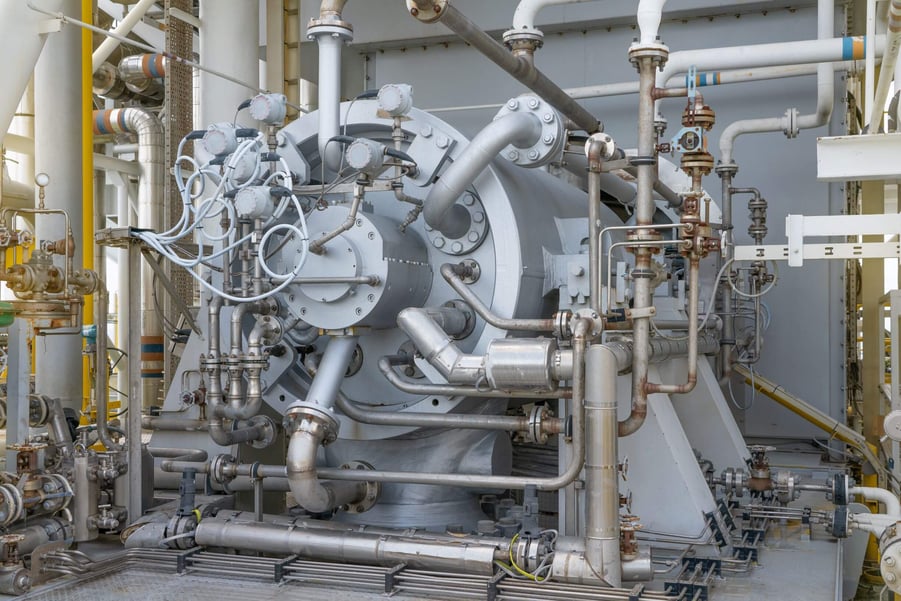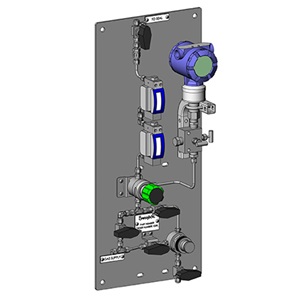Share this
Improve Rotating Equipment Dry Gas Seal Reliability: 3 Common Problems to Avoid
by Paul Lesnau on 11/10/20 7:45 AM

If you’re in the petrochemical industry you’re familiar with centrifugal compressors. They’re essential in many phases of the production cycle such as hydrocarbon processing, natural gas liquefaction, and pipeline transportation. Many compressors rely on dry gas seals (usually a dual seal arrangement) for reliable operation. Dry gas seals are machined with tolerances to allow a 3 to 10 µ gap between the rotating and stationary seal rings during compressor operations. Minute, integrated grooves in the rotating seal ring generate the gap that allows pressurized gas to infiltrate the space between the rings when the compressor is operating.
Maintaining the required pressure and flow of clean, dry gas (typically nitrogen) to the dual seals is critical to reliable compressor functioning. The gas supply must be free of particulates that could clog the grooves or expand the seal gap. Without the proper gas flow, you’ll experience overheating and contamination that eventually leads to dry gas seal failure. When you’re dealing with hydrocarbons, seal failure can result in leakage that may subject you to sanctions from Cal/OSHA or BAAQMD.
There are a few important steps that operations personnel can take to help ensure the reliability of rotating equipment that uses dry gas seals. Below I describe three common problems that jeopardize dry gas seal reliability, then explain how a properly configured seal support system such as API Plan 74 helps prevent these problems.
#1) Rotating Equipment: Dry Gas Seals Don’t Do Dirt
Problem: The minute grooves on dry seal faces force the pressurized nitrogen between the rotating and stationary faces to provide needed lubrication. With such close tolerances, microscopic particles (aka dirt) in the nitrogen supply can plug the grooves and damage seal faces.
Solution: To avoid these contaminants, best practices recommend using supply line filters that can trap particulates 1 µ or larger that may be present in the nitrogen supply.
Problem: Compressor casings can also be a source of dirt. If you can’t deliver the required gas pressure to a dual seal during compressor startup or shutdown dirty gas from the compressor casing can enter the seal chamber and foul the seal faces and seal components.
Solution: You’ll avoid both of these problems with a seal support system that delivers clean, dry gas at constant pressure and flow regardless of the operating state of the compressor.
#2) Seal Components: Must Be Compatible With Process Gas
Problem: Dry gas mechanical seals have components (O-rings, V-rings, U-rings) designed to contain process gas within the compressor casing. If these components are not compatible with process gas they’re exposed to, they’ll eventually deteriorate and lead to excessive leakage of nitrogen into the compressor. Without a careful diagnosis of the problem, you could easily confuse the leakage with mechanical seal face failure.
Solution: When you’re selecting a dry gas mechanical seal for the process, or if there’s been a change in the process gas, make sure that components such as elastomers used in the dry gas seal are compatible with the process gas.
#3) Lubrication: Nitrogen Gas Is Good, Oil Is Bad
Problem: Lack of proper lubrication can accelerate the deterioration of many types of rotating equipment. But in the case of centrifugal compressors, oil-based lubrication needs to stay in its place. Upstream compressors (oil-flooded screw, oil-lubricated reciprocating, or oil-sealed turbo) can introduce oil into the process gas flow. When a seal support system fails to deliver the proper gas pressure in a dual seal the oil-tainted gas flow from an upstream compressor can infiltrate a downstream compressor’s mechanical seals and ruin their effectiveness. Friction, heat, and failure are likely outcomes.
Solution: Oil-tainted process gas is really just another type of contaminant that dry gas seals cannot tolerate. A consistent, clean, pressurized flow of nitrogen to the dual seal is the most effective means to combat this problem.
Rotating Equipment Dry Gas Seal Reliability Relies on the Proper Seal Support System
Rotating equipment dry gas seal reliability relies on the right seal support system configured for the specific process application. I’ll use API Plan 74 (Barrier Gas) to illustrate how a properly-configured system prevents dirt and oil contamination from degrading compressor performance.
 |
API Plan 74 Control Panel delivers pressurized nitrogen to a dual mechanical seal to help ensure reliable centrifugal compressor operations. API Plan 74 delivers pressurized gas (usually nitrogen) from an external source to a dual mechanical seal. A properly-configured plan eliminates the problems mentioned above that could lead to dry gas mechanical seal failure in a compressor. The table below explains how these key features improve rotating equipment dry gas seal reliability. |
| API Plan 74 Features | Reliability Benefit |
| Continuous supply of clean dry gas delivered at the proper temperature, pressure, and flow | Maintains the proper seal chamber environment regardless of the compressor state (startup, running, shutdown, idle) |
| Pressure regulator ensures nitrogen supply is delivered at least 25 psi (1.7 bar) above the seal chamber pressure | Lubricate seal faces and prevent process fluid particulates from entering between seal faces |
| Gas supply flowmeter with a transmitter on the gas supply panel | Alert to an increased flow of nitrogen that could indicate mechanical seal failure |
| Coalescing filter on the nitrogen supply line | Remove any particulates and moisture that may be present in the nitrogen supply |
Adequate seal gas filtration, conditioning, and seal gas flow are the key factors to prevent this type of contamination from entering the seal. Whenever pressure is present in the compressor it’s critical to maintain the required pressure and flow of clean, dry gas.
Key Factors in Improving Rotating Equipment Dry Gas Seal Reliability
When you consider the investments in centrifugal compressors and the critical role they play in transforming and moving volumes of hydrocarbons through production and distribution, it’s hard to believe that minute particles of dirt can lead to malfunction and failure. Any investment in a centrifugal compressor should be matched with a seal support system tailored to the specific needs of the compressor.
Seal panel instrumentation, gas supply source and infrastructure, process gas, and mechanical seal components are key factors to consider when designing the solution to maintain the required seal chamber environment. For many organizations that can be a tall challenge, and in those instances, the guidance of an experienced mechanical seal support partner is the smartest way to solve the problem.
Swagelok: Local Support for Dry Gas Seal Reliability
At Swagelok, we understand the criticality of rotating equipment that uses dry gas seals and have been designing and delivering seal support solutions for petrochemical industries in Northern California and Western Nevada for many years. Our experienced and certified Field Engineers are available for on-site or online consultation. We’ll invest the time to understand your unique seal support system concerns. With this detailed understanding, we’ll design, fabricate, and thoroughly test your dry gas seal support systems in our local facilities. The result? Improved rotating equipment dry gas seal reliability to keep your operations running smoothly.
To learn how Swagelok Northern California can help you improve the reliability of rotating equipment that uses dry gas seals, contact our team today by calling 510-933-6200.
 About Paul Lesnau | Sales Manager, Business Development Manager, and Field Engineer
About Paul Lesnau | Sales Manager, Business Development Manager, and Field Engineer
Paul holds a B.S. in Mechanical Engineering from North Dakota State University. Before joining Swagelok Northern California, he was the West Coast Regional Sales Manager for an organization focused within the pneumatic and hydraulic industry where he supervised product distribution throughout the western United States, Canada, and Mexico. While in this role, he was able to help provide technical and application-specific expertise to customers and distribution to drive specifications.
Share this
- Archive (465)
- Assembly Services (207)
- About (100)
- Seal Support Systems (96)
- Best Practices (88)
- Training Services (74)
- Fittings (51)
- Semiconductor Applications (49)
- Hoses and Flexible Tubing (47)
- Regulators (44)
- Tubing (42)
- Grab Sampling Systems (32)
- Sampling Systems (32)
- Gas Systems (30)
- Services (30)
- Downloads (29)
- Valves (24)
- Application Support (18)
- Orbital Welding (17)
- Case Studies (13)
- Steam Systems (13)
- Frequently Asked Questions (12)
- Tools (12)
- Measurement Devices (7)
- Subsystems (6)
- Thermal Management (6)
- September 2023 (1)
- August 2023 (2)
- June 2023 (1)
- March 2023 (3)
- February 2023 (3)
- January 2023 (4)
- December 2022 (4)
- November 2022 (4)
- October 2022 (4)
- September 2022 (1)
- August 2022 (3)
- July 2022 (2)
- June 2022 (4)
- May 2022 (1)
- April 2022 (2)
- March 2022 (1)
- February 2022 (2)
- January 2022 (3)
- December 2021 (1)
- November 2021 (6)
- October 2021 (6)
- September 2021 (8)
- August 2021 (4)
- July 2021 (3)
- June 2021 (6)
- May 2021 (6)
- April 2021 (7)
- March 2021 (5)
- February 2021 (4)
- January 2021 (6)
- December 2020 (5)
- November 2020 (6)
- October 2020 (6)
- September 2020 (8)
- August 2020 (7)
- July 2020 (8)
- June 2020 (8)
- May 2020 (6)
- April 2020 (9)
- March 2020 (7)
- February 2020 (10)
- January 2020 (21)
- December 2019 (23)
- November 2019 (21)
- October 2019 (22)
- September 2019 (21)
- August 2019 (22)
- July 2019 (23)
- June 2019 (20)
- May 2019 (23)
- April 2019 (22)
- March 2019 (21)
- February 2019 (20)
- January 2019 (21)
- December 2018 (14)
- November 2018 (19)
- October 2018 (23)
- September 2018 (17)
- August 2018 (29)
- July 2018 (11)
- June 2018 (6)
- May 2018 (5)
- April 2018 (4)
- March 2018 (5)
- February 2018 (3)
- January 2018 (3)
- December 2017 (2)
- November 2017 (4)
- October 2017 (3)
- September 2017 (2)
- August 2017 (6)
- July 2017 (4)
- June 2017 (4)
- May 2017 (4)
- April 2017 (3)
- March 2017 (4)
- February 2017 (3)
- January 2017 (3)
- December 2016 (3)
- November 2016 (3)
- October 2016 (3)
- September 2016 (5)
- August 2016 (5)
- July 2016 (4)
- June 2016 (5)
- May 2016 (3)
- April 2016 (4)
- March 2016 (5)
- February 2016 (11)
- January 2016 (1)
- December 2015 (3)
- November 2015 (4)
- October 2015 (3)
- September 2015 (4)
- August 2015 (4)
- July 2015 (8)
- June 2015 (5)
- May 2015 (3)
- April 2015 (4)
- March 2015 (4)
- February 2015 (3)
- January 2015 (4)
- December 2014 (2)
- November 2014 (3)
- October 2014 (4)
- September 2014 (4)
- August 2014 (4)
- July 2014 (5)
- June 2014 (4)
- May 2014 (4)
- April 2014 (5)
- March 2014 (4)
- February 2014 (3)
- January 2014 (4)
- December 2013 (5)
- November 2013 (3)
- October 2013 (4)
- September 2013 (3)
- August 2013 (5)
- July 2013 (5)
- June 2013 (5)
- May 2013 (3)
- April 2013 (6)
- March 2013 (4)
- February 2013 (4)
- January 2013 (8)
- December 2012 (4)
- November 2012 (6)
- October 2012 (6)
- September 2012 (4)
- August 2012 (4)
- July 2012 (4)
- June 2012 (4)

.webp?width=210&height=70&name=StickyLogo%20(5).webp)